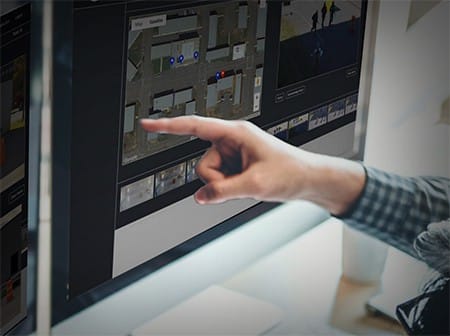Last month, an active shooter carrying numerous magazines fired shots within a Target store in Omaha, Nebraska. Officers eventually shot the suspect and thankfully, no civilians were killed. According to local reports, during the incident some employees did what came instinctively: they ran.
In January of 2023 in Evansville, Indiana, a former Walmart employee shot one person and chased more throughout the store. The person who made the 911 call escaped the situation and hid in the back office of the store.
Finally, in Denver, Colorado just a few years ago, a high schooler lunged at a shooter at his STEM school. He lost his life, but likely saved others in the process.
All three actions demonstrated by employees and students reflect a part of the Run, Hide, Fight active shooter recommended instructions that were released in 2012. The City of Houston created the Run, Hide, Fight training video with funding from the Department of Homeland Security (DHS), and these instructions are adopted by the FBI and DHS today.
While other organizations may differ slightly on the wording (such as “avoid, deny, defend”), the basic message has been consistent and is reinforced by law enforcement nearly everywhere and considered best practice by many organizations.
But, should this protocol still be considered a best practice today? In this blog, we break down the premise of Run, Hide, Fight, dissect the flaws, and explore alternative recommendations.
What Does Run, Hide, Fight Active Shooter Training Mean?
After the Run, Hide, Fight training video was released, Dennis Storemski, the director of the Mayor’s Office of Public Safety and Homeland Security in Houston, spoke on the Texas Standard about how “Run, Hide, Fight” came to be.
“[…]here’s nothing out there telling the general public, the average citizen, what they should do if they get involved in an active shooter event,” Storemski said. “So using grant funds, we developed this video about how to respond and we needed a catchy phrase that people could remember.”
Similar to phrases like “Stop, Drop, and Roll,” the phrase “Run, Hide, Fight” serves as a quick reminder of the three recommended actions you can take when an active shooter is nearby a school or business. To summarize the steps:
Run means to find an escape or exit immediately if far away enough from the shooter. You should leave any belongings behind, take others with you if they’re willing, call 911 when it’s finally safe, and always keep your hands visible to law enforcement when they arrive.
Hide is to get out of view from the shooter, preferably in a locked room. There, you should block the entry and barricade yourself if possible and remain quiet. During this time, you should also silence cell phones, turn off lights, and stay in one place until you’re sure help or law enforcement has arrived.
Fight means using physical force in any way possible to either disrupt or incapacitate the shooter as a last resort if your life appears in imminent danger. This is the time to throw caution to the wind and improvise by using any nearby object to attack or throw at the shooter. If you can’t run or hide, it’s believed your best bet for survival is to incapacitate a shooter by fighting.
The Department of Homeland Security (DHS) also provides extended instructions for how to respond when law enforcement does arrive and tips for training staff for an active shooter situation, but for this blog, we’ll focus on Run, Hide, Fight.
Is Run, Hide, Fight Active Shooter Training Still Relevant to Businesses and Schools?
Since the Sandy Hook massacre of 2012, the three-step Run, Hide, Fight strategy has been a dominant theme in active shooter training in workplaces and schools for two main reasons: it’s simple and it’s easy to remember.
However, there’s a vital flaw that can make Run, Hide, Fight more problematic than helpful, and it’s the lack of critical situational awareness in most active shooter cases.
“Run, Hide, Fight breaks down because you don’t know what situation you’re in,” David Riedman, Founder of the K-12 School Shooting Database, says. “And if you don’t have that situational awareness, you don’t know the best action to take.”
Run, Hide, Fight presents straightforward, sequential steps. But depending on the circumstances, safety leaders may need to provide more nuanced guidance—and this is where critical situational awareness becomes vital.
Example #1: Michigan State University Shooting
Riedman explains that during the Michigan State University (MSU) shooting, students received conflicting messages, some advising them to shelter in place and others advising them to run.
These conflicting messages stemmed from a lack of situational awareness. Officials were unsure if there was one shooter or multiple shooters, and they didn’t know where the shooter was located.
Given that MSU is one of the largest campuses in the U.S. with a campus spanning over 5,000 acres, this is understandable. However, proactive visual gun detection installed on their camera network could have provided them with the situational awareness needed to provide immediate guidance.
“If they had ZeroEyes, there would have been a picture of a single shooter entering that building with a gun within seconds, and you could definitively give guidance with that situational awareness,” Riedman says. “If you’re in this building, run. If you’re anywhere else on campus, shelter in place.”
Example #2: Mandalay Bay Shooting
The Mandalay Bay shooting in 2017 is another prime example of when Run, Hide, Fight breaks down due to a lack of situational awareness. The gunman was stationed at the window of his hotel room on the 32nd floor and began firing rounds at a concert across the street.
Concertgoers tried to run but did not know the safest direction to head toward. Due to the crowd, most tried to take cover on the ground. When officers arrived on the scene, they re-directed people who were running towards the line of fire.
Instinctively, people want to run from danger, but this can be dangerous when there isn’t any situational awareness of the shooter’s location or understanding of the weaponry they’re armed with.
A journalist recounts that as the shooting was happening, gamblers inside the hotel fled—but given the shooter’s location and line of fire, they may have been safer inside the building than running outside and potentially crossing the line of fire.
Situational Awareness Is Needed for Active Shooter Guidance
The main reason Run, Hide, Fight is flawed is because these steps are not applicable or recommended in every scenario.
Each active shooter situation is incredibly nuanced and real-time situational awareness is needed to inform people of the best action to take.
Why “Hide” and “Fight” Receive Criticism
We’ve discussed why a formulaic protocol like Run, Hide, Fight doesn’t work—but we haven’t yet touched on why “Hide” and “Fight,” in particular, can be dangerous recommendations.
Criticism against “hide”
Generally, hiding is not a good course of action. Especially since many people tend to skip over “Run” and go straight into hiding as the first step. Take schools, for example. Instead of running away from danger, the first step is locking a classroom and hiding under desks.
Hiding, instead of getting away from the danger, is how students are taught to respond to a school shooting. But passively hiding doesn’t help if a shooter barricades themselves into a room with students. It doesn’t help move students away from the danger. And it doesn’t help if the shooter starts a fire or sets off a bomb.
Instead of hiding and waiting for the shooter to potentially find you, newer guidance advises that you keep your distance from the shooter and create barriers. Rather than sitting tight in one spot, you would look for opportunities to covertly move further away from the shooter and closer to a safe spot.
Criticism against “fight”
There has been a lot of debate around the guidance to “fight.” According to the FBI-adopted protocol, “fight” should only be used as a last resort. Others say it’s better to confront the shooter sooner or as a first option.
The reality is, “fight” is not an option for most people. Young children should not be advised or expected to fight against a mass shooter, and there are also many people who are simply not physically capable of fighting back against a shooter.
Even those who have received self-defense or combat training may not be inclined to fight back. The reality of a mass shooter event is significantly different than any practice or training one can receive.
Potential alternatives
Some prefer an alternative short approach such as “Move, Escape or Attack” for its potential to be more efficient and flexible to the unique situation. Or even something as simple as, “Get Safe, Stay Safe,” as a way to remind people to move to safety if they can, and stay where they’re safe.
For the ultimate fluid response to an active shooter, others have argued to abandon all protocols and to react with their gut instincts. A person’s gut instincts aren’t necessarily driven by feeling alone—there is also subconscious decision-making at play as well. An example of that is the “OODA loop” framework:
- Observe: What information can you take in with your five senses? See, hear, smell, feel, taste?
- Orient: If you sense something wrong, where are you in regard to that?
- Decide: Based on what you observe and where you are oriented, what is the best path to take you away from the danger and towards a safe place?
- Act: Take action.
While the OODA loop may seem like a lot, the more you practice it, the more it becomes second nature. It’s a decision-making tool that can be used in numerous life situations and is not limited to active shooter response. In a dangerous situation, the entire OODA loop can happen in seconds, or even fractions of a second.
In either case, better situational awareness will always help improve active shooter response.
Can You Prevent a Run, Hide, Fight Scenario with Better Situational Awareness?
In an active shooter situation, there’s no such thing as a one-size-fits-all protocol because each scenario has unique circumstances. The best thing that schools and organizations can provide to better respond and protect their people is real-time, reliable situational awareness.
“There’s no scenario where better situational awareness isn’t helpful,” Riedman explains. “There are a lot of scenarios where a metal detector might have limited effectiveness. A ballistic window or a smoke screen might have limited effectiveness.”
“But in every single scenario, having pictures of the shooter and knowing exactly where they are is always a benefit.”
While a universal protocol for active shooter response doesn’t exist, advanced critical situational awareness can help decision-makers provide rapid guidance that makes the most sense and saves the most lives. ZeroEyes’ software provides your security personnel and local law enforcement with verified visual gun detection alerts and real-time updates of the shooter’s precise geolocation and photograph.
To see how our solution works in action, you can request a free live demo here.

See How ZeroEyes Works
Request a free live demo to see how ZeroEyes’ Proactive Visual Gun Detection solution uses your existing digital video cameras to provide situational awareness during an active shooter event.

